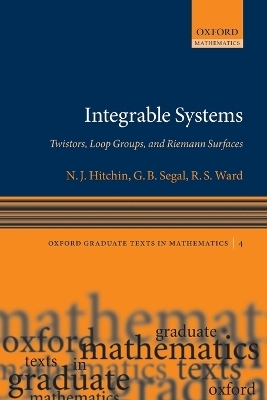
Integrable Systems
Twistors, Loop Groups, and Riemann Surfaces
Seiten
2013
Oxford University Press (Verlag)
978-0-19-967677-4 (ISBN)
Oxford University Press (Verlag)
978-0-19-967677-4 (ISBN)
Designed to give graduate students an understanding of integrable systems via the study of Riemann surfaces, loop groups, and twistors, this book has its origins in a lecture series given by the internationally renowned authors. Written in an accessible, informal style, it fills a gap in the existing literature.
This textbook is designed to give graduate students an understanding of integrable systems via the study of Riemann surfaces, loop groups, and twistors. The book has its origins in a series of lecture courses given by the authors, all of whom are internationally known mathematicians and renowned expositors. It is written in an accessible and informal style, and fills a gap in the existing literature. The introduction by Nigel Hitchin addresses the meaning of integrability: how do we recognize an integrable system? His own contribution then develops connections with algebraic geometry, and includes an introduction to Riemann surfaces, sheaves, and line bundles. Graeme Segal takes the Kortewegde Vries and nonlinear Schrödinger equations as central examples, and explores the mathematical structures underlying the inverse scattering transform. He explains the roles of loop groups, the Grassmannian, and algebraic curves. In the final part of the book, Richard Ward explores the connection between integrability and the self-dual Yang-Mills equations, and describes the correspondence between solutions to integrable equations and holomorphic vector bundles over twistor space.
This textbook is designed to give graduate students an understanding of integrable systems via the study of Riemann surfaces, loop groups, and twistors. The book has its origins in a series of lecture courses given by the authors, all of whom are internationally known mathematicians and renowned expositors. It is written in an accessible and informal style, and fills a gap in the existing literature. The introduction by Nigel Hitchin addresses the meaning of integrability: how do we recognize an integrable system? His own contribution then develops connections with algebraic geometry, and includes an introduction to Riemann surfaces, sheaves, and line bundles. Graeme Segal takes the Kortewegde Vries and nonlinear Schrödinger equations as central examples, and explores the mathematical structures underlying the inverse scattering transform. He explains the roles of loop groups, the Grassmannian, and algebraic curves. In the final part of the book, Richard Ward explores the connection between integrability and the self-dual Yang-Mills equations, and describes the correspondence between solutions to integrable equations and holomorphic vector bundles over twistor space.
Nigel Hitchin is Savilian Professor of Geometry at the University of Oxford Graeme Segal is Emeritus Fellow of All Souls College, University of Oxford Richard Ward is Professor in the Department of Mathematical Sciences, Durham University
1. Introduction ; 2. Riemann surfaces and integrable systems ; 3. Integrable systems and inverse scattering ; 4. Integrable systems and twistors ; Index
| Erscheint lt. Verlag | 15.3.2013 |
|---|---|
| Reihe/Serie | Oxford Graduate Texts in Mathematics ; 4 |
| Verlagsort | Oxford |
| Sprache | englisch |
| Maße | 157 x 233 mm |
| Gewicht | 258 g |
| Themenwelt | Mathematik / Informatik ► Mathematik ► Analysis |
| Mathematik / Informatik ► Mathematik ► Geometrie / Topologie | |
| Naturwissenschaften ► Physik / Astronomie | |
| ISBN-10 | 0-19-967677-1 / 0199676771 |
| ISBN-13 | 978-0-19-967677-4 / 9780199676774 |
| Zustand | Neuware |
| Haben Sie eine Frage zum Produkt? |
Mehr entdecken
aus dem Bereich
aus dem Bereich
Buch | Softcover (2024)
De Gruyter Oldenbourg (Verlag)
CHF 83,90
Buch | Softcover (2024)
De Gruyter Oldenbourg (Verlag)
CHF 83,90


